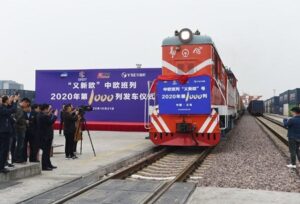By Alexander Ayertey Odonkor
EU Agriculture Commissioner Janusz Wojciechowski, accompanied by a business delegation of senior representatives from the EU agri-food sector, visited China last month.
This visit aimed to facilitate European agricultural food and beverage exports to China and broaden their footprint in the market. China is the third largest agri-food export market for the EU-27 after the U.S. and U.K.
Guided by the 2019 EU Strategic Outlook, which seeks to improve access to the Chinese market, the recent visit not only demonstrated China’s continued attractiveness to Europe but also highlighted the symbiotic economic ties between the two economies. With 2.3 billion euros ($2.4 billion) of trade per day, the relationship supports growth across various industries in China and Europe.
Through the visit, which took place from April 21 to 26, the EU sought to strengthen cooperation with relevant Chinese stakeholders in the agri-food sector and further open up new opportunities for the two parties. In 2023, China imported approximately $36 billion of agricultural products from Europe, contributing to the EU’s record surplus of agri-food trade that year.

Since China joined the World Trade Organization in 2001, trade and investment, the cornerstone of China-EU relations, have seen significant expansion and deepening. China has become the bloc’s largest partner for imports and third-largest market for exports of goods.
With the two economies accounting for over a third of the world’s gross domestic product (GDP), EU and China exports also account for over a third of the world’s total. The EU and China trade goods worth over 800 billion euros annually. Mutually beneficial, the trade and investment are a source of growth, job creation, and development for both parties.
For China, trade and investment ties with Europe, at least over the last two decades, have been instrumental in the country’s transition from labour-intensive, low-value goods to tech-intensive, high-value products, fostering job creation and lifting millions of people out of poverty.
On the other hand, China’s vast and rapidly growing domestic market, home to more than 1.4 billion people, currently the world’s second-largest consumer market and also the world’s largest middle-income group, presents enormous and diverse opportunities for EU enterprises across a range of industries, including manufacturing, food and cosmetics.
Data released by Eurostat show that in 2023, China was the largest partner for EU imports of goods (20.5%) and the third-largest partner for EU exports (8.8%). Among EU member states, in 2023, the Netherlands was the largest importer of goods from China, and Germany was the largest exporter.
For the same year, Germany, the largest economy in Europe, saw its direct investment in China rise by 4.3% to a record 11.9 billion euros, demonstrating German companies’ strong desire to expand operations in China.
In fact, on the eve of German Chancellor Olaf Scholz’s scheduled visit to China in mid-April this year, the German Chamber of Commerce in China released a report showing that though German companies currently operating in China face several challenges, they are optimistic about growth in the Chinese market.
According to the report, 79% of surveyed companies remain competitive in China and plan to make further investments.
The trend is not limited to Germany. The European Business in China Confidence Survey (2023) revealed more than 90% of surveyed firms from Europe plan to utilize China as an investment destination, with 59% of respondents indicating the Chinese market ranks among their top three investment destinations.
Similarly, a 2023 report from the China Chamber of Commerce to the EU also showed that out of the nearly 180 Chinese enterprises surveyed, 90% reported an increase in revenue in the EU, up from 70% in the previous year. The report further revealed that about 80% of companies planned to invest more in Europe, though 63% were grappling with the EU’s “de-risking” approach.

According to the EU, the growing complexity of China-EU relations amid evolving geopolitical landscapes compels the bloc to prioritize what it calls the “reduction of vulnerabilities and the enhancement of resilience.” In other words, the EU is “de-risking” its interactions with China. However, given China’s prominence in global supply chains, dominance in emerging industries, together with its huge domestic market, the bloc’s attempts to “de-risk” from the Asian giant will undoubtedly do more harm than good, especially in the long term.
Yet, China sees the EU as a key partner for economic and trade cooperation, as the country has stayed committed to innovation-driven growth and high-level opening-up, sharing the gains of trade and development with countries worldwide through several initiatives, including the Belt and Road Initiative.
The future course for sustained economic and trade ties between China and the EU could be reflected in President Xi Jinping’s remarks at a China-France-EU trilateral meeting with French President Emmanuel Macron and European Commission President Ursula von der Leyen at Elysee Palace on Monday.
Xi said China-EU cooperation is in essence complementary and mutually beneficial, and the two sides have extensive common interests and broad space for cooperation in green and digital transition.
China and the EU should make good preparations for a new round of China-EU Summit and for high-level dialogues in the strategic, economic and trade, green, and digital fields, and foster a partnership on industrial and supply chains featuring stability and mutual trust, he said.
This article was first published by China’s Diplomacy in the New Era: chinadiplomacy.org.cn
About the Author
Alexander Ayertey Odonkor is a global economist with a keen interest in the social, environmental and economic landscape of developed countries, emerging markets and developing economies, particularly in Asia-Pacific, Africa, Europe and North America.










